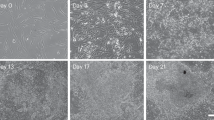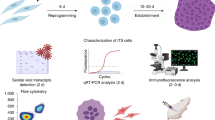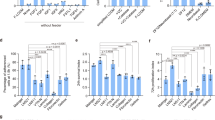Abstract
Clinical application of embryonic stem (ES) cells faces difficulties regarding use of embryos, as well as tissue rejection after implantation. One way to circumvent these issues is to generate pluripotent stem cells directly from somatic cells. Somatic cells can be reprogrammed to an embryonic-like state by the injection of a nucleus into an enucleated oocyte or by fusion with ES cells. However, little is known about the mechanisms underlying these processes. We have recently shown that the combination of four transcription factors can generate ES-like pluripotent stem cells directly from mouse fibroblast cultures. The cells, named induced pluripotent stem (iPS) cells, can be differentiated into three germ layers and committed to chimeric mice. Here we describe detailed methods and tips for the generation of iPS cells.
This is a preview of subscription content, access via your institution
Access options
Subscribe to this journal
Receive 12 print issues and online access
$259.00 per year
only $21.58 per issue
Buy this article
- Purchase on SpringerLink
- Instant access to full article PDF
Prices may be subject to local taxes which are calculated during checkout




Similar content being viewed by others
References
Yamanaka, S. Strategies and new developments in the generation of patient-specific pluripotent stem cells. Cell Stem Cell 1, 39–49 (2007).
Egli, D., Rosains, J., Birkhoff, G. & Eggan, K. Developmental reprogramming after chromosome transfer into mitotic mouse zygotes. Nature 447, 679–685 (2007).
Silva, J., Chambers, I., Pollard, S. & Smith, A. Nanog promotes transfer of pluripotency after cell fusion. Nature 441, 997–1001 (2006).
Surani, M.A., Hayashi, K. & Hajkova, P. Genetic and epigenetic regulators of pluripotency. Cell 128, 747–762 (2007).
Niwa, H. How is pluripotency determined and maintained? Development 134, 635–646 (2007).
Boiani, M. & Schöler, H.R. Regulatory networks in embryo-derived pluripotent stem cells. Nat. Rev. Mol. Cell. Biol. 6, 872–884 (2005).
Chambers, I. & Smith, A. Self-renewal of teratocarcinoma and embryonic stem cells. Oncogene 23, 7150–7160 (2004).
Tokuzawa, Y. et al. Fbx15 is a novel target of Oct3/4 but is dispensable for embryonic stem cell self-renewal and mouse development. Mol. Cell. Biol. 23, 2699–2708 (2003).
Takahashi, K. & Yamanaka, S. Induction of pluripotent stem cells from mouse embryonic and adult fibroblast cultures by defined factors. Cell 126, 663–676 (2006).
Okita, K., Ichisaka, T. & Yamanaka, S. Generation of germline-competent induced pluripotent stem cells. Nature 448, 313–317 (2007).
Morita, S., Kojima, T. & Kitamura, T. Plat-E: an efficient and stable system for transient packaging of retroviruses. Gene Ther. 7, 1063–1066 (2000).
McMahon, A.P. & Bradley, A. The Wnt-1 (int-1) proto-oncogene is required for development of a large region of the mouse brain. Cell 62, 1073–1085 (1990).
Acknowledgements
We are grateful to Dr. Yoshimi Tokuzawa for earlier works that were fundamental for our experiments. We also thank Tomoko Ichisaka, Megumi Narita, Yumi Ohuchi, Rie Kato and Ryoko Iyama for technical and administrative supports, and Dr. Toshio Kitamura for pMXs retroviral vectors and Plat-E cells.
Author information
Authors and Affiliations
Corresponding author
Rights and permissions
About this article
Cite this article
Takahashi, K., Okita, K., Nakagawa, M. et al. Induction of pluripotent stem cells from fibroblast cultures. Nat Protoc 2, 3081–3089 (2007). https://doi.org/10.1038/nprot.2007.418
Published:
Issue Date:
DOI: https://doi.org/10.1038/nprot.2007.418



